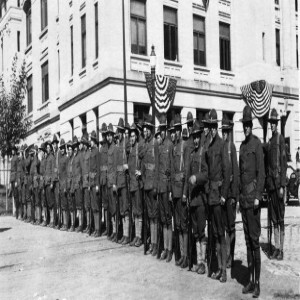
On this day in labor history, the year was 1919.
That was the day copper miners in Butte, Montana went on strike.
Mine owners announced a $1 a day wage cut when copper prices slumped in financial markets.
Swayed by the power of the Seattle General Strike then in progress, miners associated with the IWW and the Metal Mine Workers Union, Local 800 formed their own Soldiers’, Sailors’, and Workers’ Council.
They issued a call for a general strike.
For days, area trade unionists honored picket lines, left their jobs and held meetings to debate joining a general strike.
The streetcar workers shut down public transportation for five days.
Soldiers returning from the war helped man picket lines.
The labor paper, Butte Daily Bulletinreported the post-war economy left returning war heroes penniless and working in dangerous mines.
While solidarity was unanimous among workers, their unions had yet to pass formal resolutions.
Immediately, Montana’s governor, Sam V. Stewart, called in the 44th Infantry to crush the strike. Infantrymen bayoneted nine strikers, when they tried to stop the anti-labor Butte Daily Post from being distributed.
Spirits were high by the end of the first week as official voting began.
The streetcar men went back to work, citing no grievances with their employer.
Then the engineers followed. Finally the IBEW caved.
They worried the engineers would take their jobs, as they had done in a 1917 strike.
The IWW and local 800 called off the strike, fearing continuation would be fatal.
Though most of the troops were soon withdrawn, one company stayed to ensure labor peace at the local water and electric works.
Butte would remain under federal military occupation until the end of 1920.
More Episodes
 2023-10-27
2023-10-27
 2023-10-26
2023-10-26
 2023-10-26
2023-10-26
 2023-10-24
2023-10-24
 2023-10-22
2023-10-22
 2023-10-21
2023-10-21
 2023-10-19
2023-10-19
 2023-10-18
2023-10-18
 2023-10-17
2023-10-17
 2023-10-16
2023-10-16
 2023-10-15
2023-10-15
 2023-10-12
2023-10-12
 2023-10-11
2023-10-11
 2023-10-09
2023-10-09
 2023-10-09
2023-10-09
Create your
podcast in
minutes
- Full-featured podcast site
- Unlimited storage and bandwidth
- Comprehensive podcast stats
- Distribute to Apple Podcasts, Spotify, and more
- Make money with your podcast
It is Free
- Privacy Policy
- Cookie Policy
- Terms of Use
- Consent Preferences
- Copyright © 2015-2024 Podbean.com




